*My posts may contain affiliate links, which means I may receive a small commission, at no cost to you, if you make a purchase through a link! Thank you for supporting my website!*
Last updated on September 11th, 2024 at 09:28 am
Is It Better To Install Trim Or Carpet First When Remodeling? Find Out Here!
Are you mid-renovation and wondering if you should install the carpet or the trim first? Well, look no further because I have your answer!
If you want to minimize the amount of time the new carpet is walked on, install the trim before the carpet. If you want to avoid the trim being damaged during the carpet installation and ensure it is installed the correct distance above the carpet, install the carpet before the trim.
For the most part, it depends on the benefits you are trying to reap (and the disadvantages you are trying to avoid).
I had this exact question while we were renovating our own home, so I’ll break down the details further below on your different choices and the decision we came to. Then you can walk away with a confident decision!
Let’s dive in!
Quick Navigation: Carpet Or Trim First
- Benefits Of Installing Carpet Before Trim
- Benefits Of Installing Trim Before Carpet
- Carpet Or Trim First: Which Is Better?
- How To Install Trim Before Carpet
- Other FAQs About Order Of Installation For Carpet & Trim
- Final Thoughts
Benefits Of Installing Carpet Before Trim
There are a few benefits and disadvantages to installing the carpet before the trim.
| Pros Of Installing Carpet Before Trim | Cons Of Installing Carpet Before Trim |
|---|---|
| Carpet contractors are happier (baseboard is out of their way during the installation) | The carpet will be walked on a lot while installing trim |
| Trim won’t be damaged by the carpet contractors | Any debris that naturally happens while installing trim will end up in the new carpet |
| The trim will be installed at the perfect height for the new carpet |
Benefit One: Carpet Contractors Are Happier
The first benefit to installing carpet before trim is that the carpet installers will be happier that no baseboard will be in the way.
While making our decision, we point-blank asked the Home Depot carpet installers if they wanted us to install the baseboard first or to wait.
These specific contractors preferred that we waited because it makes their job easier when the baseboard isn’t there (although most of the time, they do install carpet with baseboard already installed, so this was not a deal breaker).
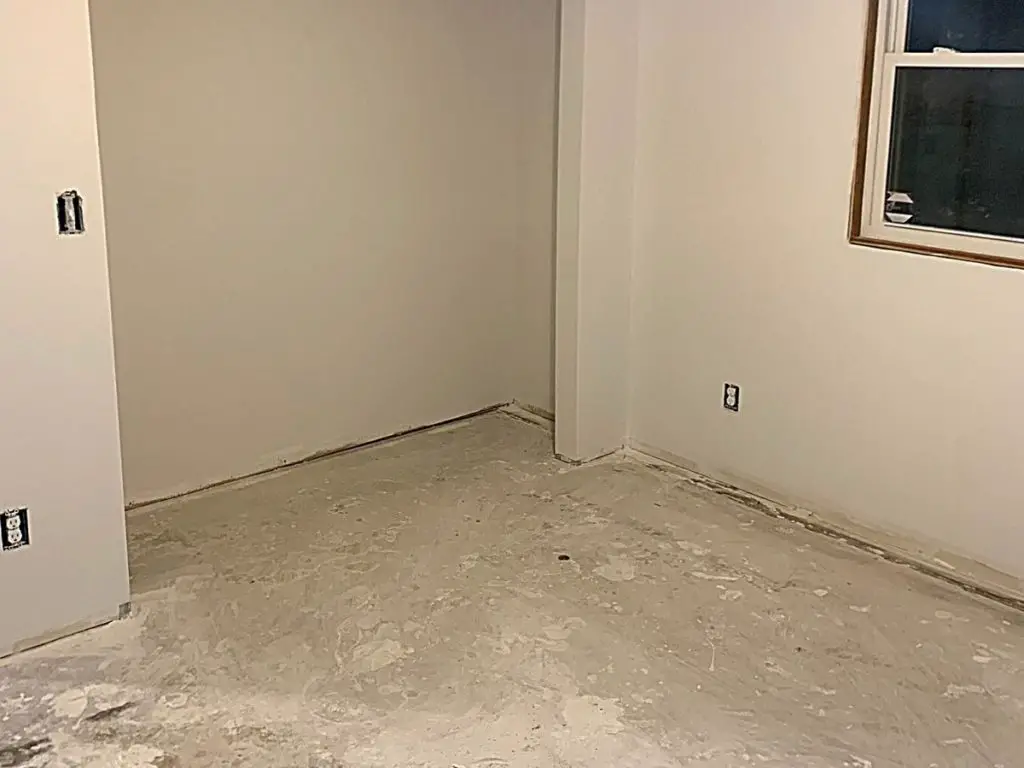
Benefit Two: Trim Won’t Be Damaged
The next benefit to installing carpet before trim is that the new trim won’t be damaged.
When carpet is installed, it’s in giant rolls that kinda get thrown around. Sometimes that can damage the surrounding wall and baseboard.
Of course, if you have a highly skilled contractor, then the likelihood of this happening is very low.
But some contractors just aren’t as gentle, so a tiny bit of damage can occur.
If the baseboard isn’t installed yet, then you don’t have to worry about this at all.
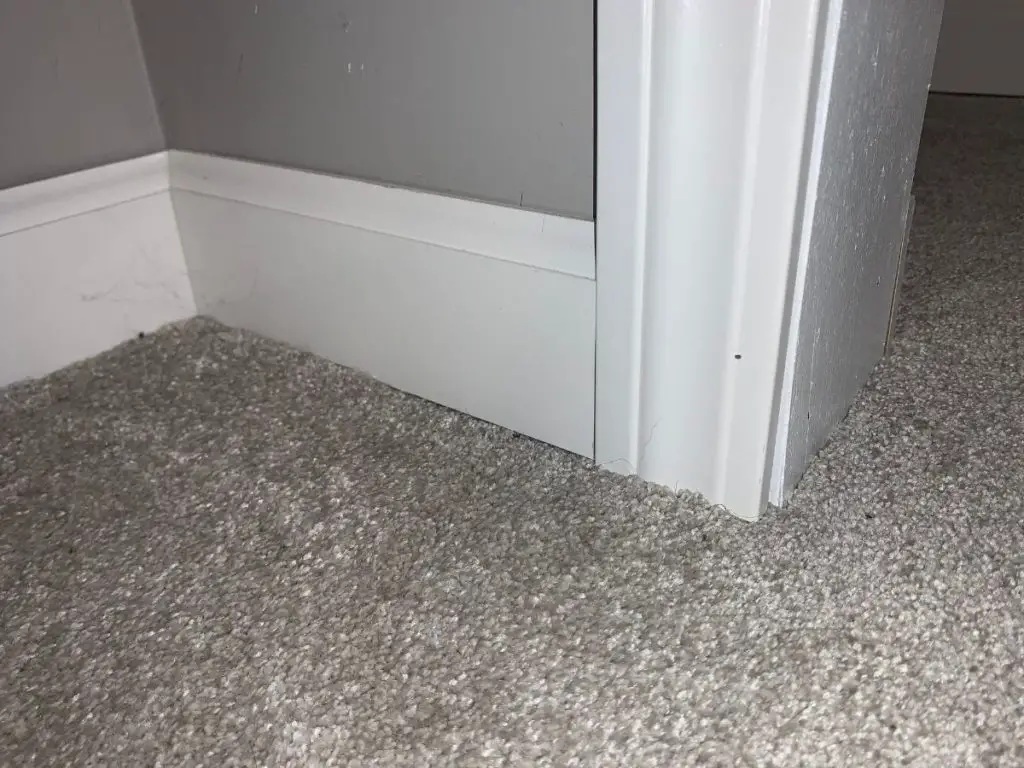
Benefit Three: Trim Will Be Installed At The Correct Height
The final benefit to installing carpet before trim is that the trim will be installed at the correct height of the new carpet.
Without the carpet being installed, you will have to guess the correct distance above the subfloor to install the baseboard.
As a general rule of thumb, a 1-inch gap should give plenty of room for carpet to be installed without leaving a large gap between the carpet and trim.
However, this distance is dependent upon the thickness of your new carpet and carpet pad.
If the carpet is installed first, then there is no guessing. The trim can be installed right over the new carpet.

Drawback One: New Carpet Will Be Walked On During Trim Installation
The first drawback to installing carpet before trim is that you will have to work over (and walk on) the new carpet to install the trim after the fact.
While this is not a big deal, it will require you to constantly take your shoes off or put on some type of shoe cover to avoid getting dirt and debris on the new carpet.
It helps if you are installing baseboard with multiple people, though.
One person can be the designated cutter (that leaves their shoes on to go and cut the baseboard), and the other can be the designated installer (that leaves their shoes off and gets measurements/nails the pieces in place).
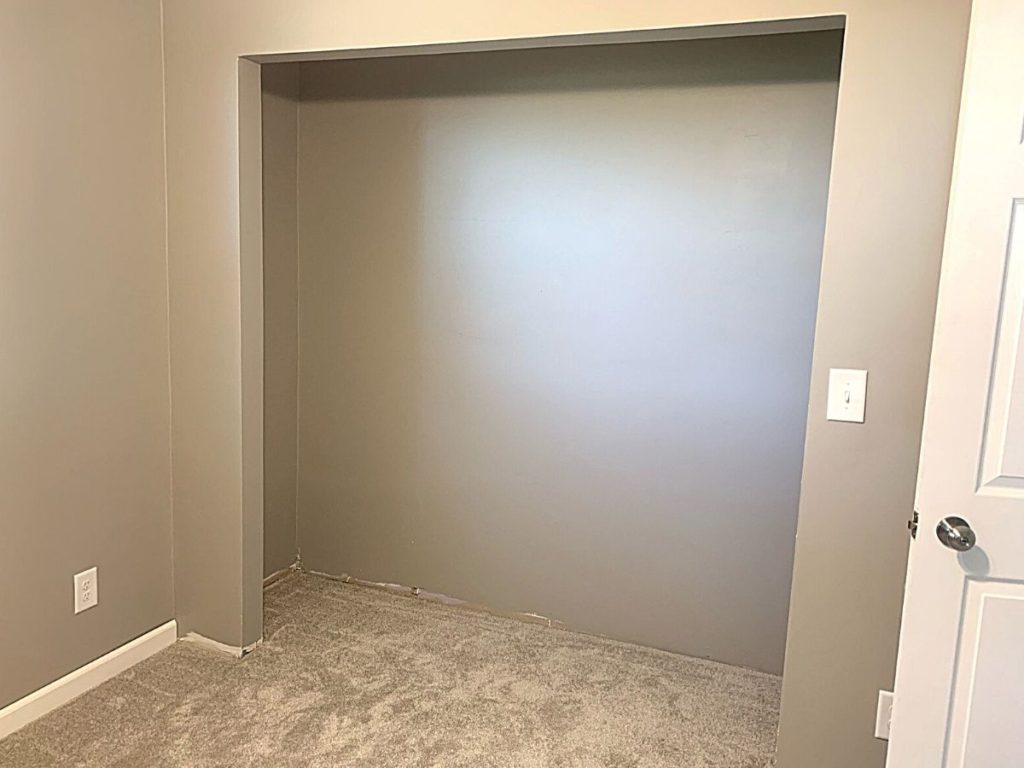
Drawback Two: Trim Installation Might Get Some Debris In The New Carpet
The final drawback to installing carpet before trim is that some debris from the trim installation can get in the carpet.
For the most part, installing trim is not messy. But if you are caulking or need to sand wood filler to hide the nail heads, then some of that debris can get in the new carpet.
Benefits Of Installing Trim Before Carpet
- Trim can be installed whenever, don’t have to wait for contractors to be done with carpet
- Carpet installers will make sure the carpet is all the way at the edge and tucked under the trim
- No need to work on the clean carpet – all debris, tools, and boots can stay off the new carpet
There are a few benefits and disadvantages to installing the trim before the carpet.
| Pros Of Installing Trim Before Carpet | Cons Of Installing Trim Before Carpet |
|---|---|
| Trim can be installed whenever (no waiting on carpet contractor schedule) | Trim needs to be installed with a gap between the subfloor and the trim |
| All debris, tools, and shoes can stay off the new carpet | The trim can be damaged during the carpet installation |
Benefit One: Trim Can Be Installed Whenever
The first benefit to installing trim before carpet is that the trim can be installed whenever.
One of the more frustrating parts of renovating is the fact that you can’t finish project Y until project X is complete.
With trim and carpet, however, that is not the case.
If the carpet installers are scheduled out for another month and a half and you want to keep working on your renovation, you can install the trim while you are waiting.
You have some flexibility in the order of operations in this case.
Benefit Two: The New Carpet Will Stay Clean
The final benefit to installing trim before carpet is that you can minimize the amount of work that needs to be done after the carpet is installed.
For most rooms, the carpet can be the last project in the room. This is awesome because you know it won’t get dirty from other projects (such as working on the trim).
A lot of contractors will install the trim before the carpet solely for this benefit.
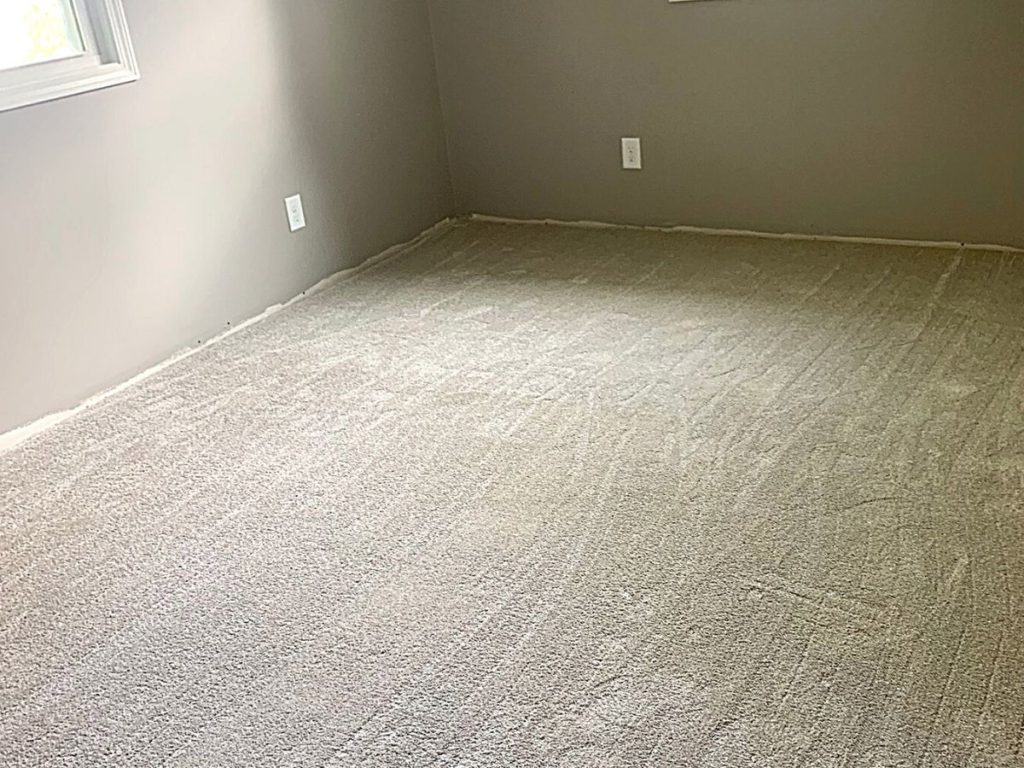
Drawback One: Trim Needs To Be Installed With A Gap
The first drawback to installing trim before carpet is that the trim needs to be installed high enough to leave room for the carpet to be installed.
Honestly, this was one of the biggest reasons why we waited until after the carpet was installed to install the baseboard.
There was no guessing or needing to fix the baseboard that was installed at the wrong height.
If you know the thickness of the carpet and the carpet pad, then this is less of a problem for you.
Drawback Two: Trim Can Be Damaged While The Carpet Is Installed
The final drawback to installing trim before carpet is that the trim can get a little beat up during the carpet installation.
Just as we discussed above, the damage, if any, should be no more than a few scuffs or knicks in the paint (dependent upon how soft of a material your baseboard is).
It’s more of an annoyance than anything to worry about.
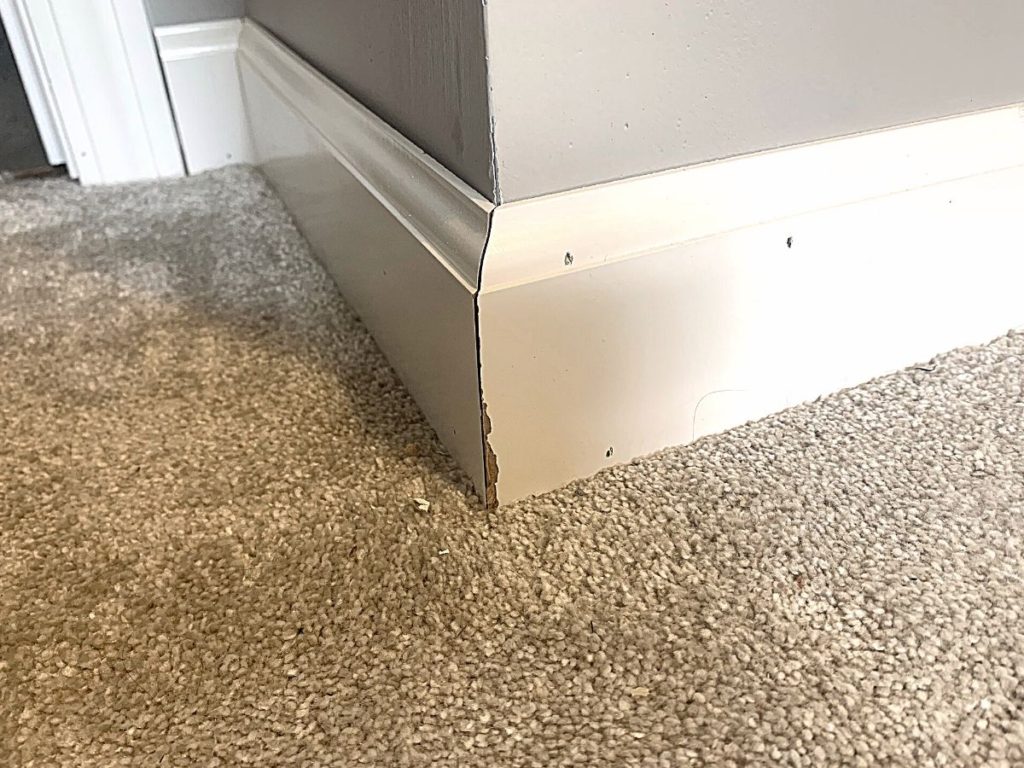
Carpet Or Trim First: Which Is Better?
So, now that you’ve heard all of the arguments, I’m sure you are wondering, is it better to install the carpet or the trim first?
Here’s the final verdict:
If it is a new construction/full renovation and the baseboard has not been installed yet, then install the carpet before the trim. If the baseboard is already installed, then do not remove it. Just install the carpet after the trim.
I personally found it easier on both us and the contractors to install the carpet before the trim – the contractors had plenty of room to work, and I knew for sure we weren’t leaving too big of a gap between the baseboard and carpet.
There is no right or wrong answer though. You can install the trim first if the contractors cannot install the carpet before you have time to get the baseboard installed.

Other FAQs About Order Of Installation For Carpet & Trim
Here are some other frequently asked questions about which order you should install the carpet and trim to help you knock out your home renovation with ease!
What Height Should You Set Baseboards Before Carpet Is Installed?
Baseboards should be installed 1 inch or the thickness of your carpet and carpet padding combined above the subfloor before the carpet is installed. At this height, the carpet can still be tucked underneath.
How Do You Fill A Gap Between Carpet & Baseboard?
You can fill a gap between carpet and baseboard by installing shoe moulding or quarter-round over the gap.
I have a full tutorial on all of your options to fill the gap and how to tackle this rather simple, but highly valuable DIY project. Check it out here.
Final Thoughts On Installing Trim Or Carpet First
There you have it!
There really is no wrong way to go about this. Just choose an order and keep on trucking through your renovation.
Hopefully, this helps ease your mind that you are on the right path.
Catch you in my next post!
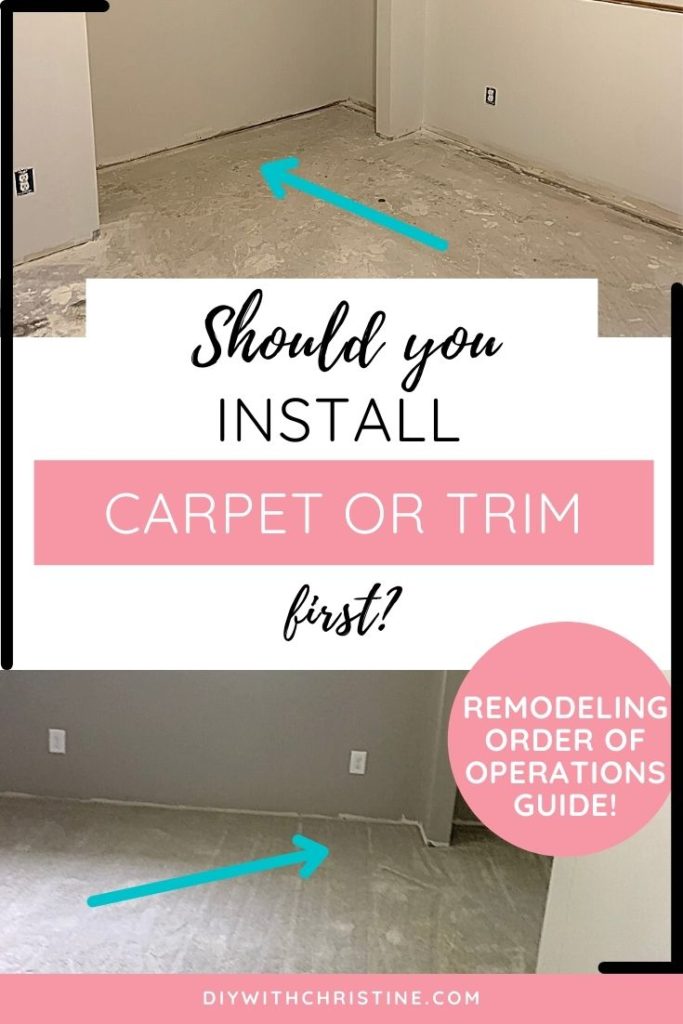

By Christine
Christine is a blogger and DIYer who tackles home renovation and decorating projects alongside her husband, Adam, for their personal residence and rental properties. Although she successfully tackles large renovation projects to avoid expensive contractor fees and bring her vision to life now, her path to success was not easy.
Go here to read her story, “From a Clueless First-Time Homebuyer To A Confident DIYer Creating Her Dream Home One Project At A Time“.
Popular Posts
DIY With Christine is a participant in the Amazon Services LLC Associates Program, an affiliate advertising program designed to provide a means for sites to earn advertising fees by advertising and linking to Amazon.com.






